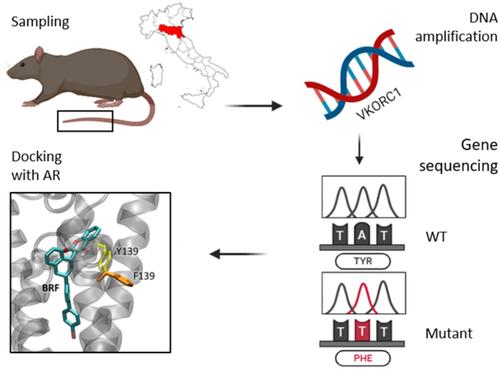当前位置:
X-MOL 学术
›
Pest Manag. Sci.
›
论文详情
Our official English website, www.x-mol.net, welcomes your
feedback! (Note: you will need to create a separate account there.)
New polymorphisms of Vkork1 gene related to anticoagulant resistance of rats and mice in Italy
Pest Management Science ( IF 3.8 ) Pub Date : 2025-01-16 , DOI: 10.1002/ps.8652
Alessandro Reggiani, Gianluca Rugna, Eugenia Polverini, Rodolfo Veronesi, Romeo Bellini, Claudio Venturelli, Filippo Maria Dini, Roberta Galuppi, Guglielmo Pampiglione, Michele Dottori, Elena Carra
Pest Management Science ( IF 3.8 ) Pub Date : 2025-01-16 , DOI: 10.1002/ps.8652
Alessandro Reggiani, Gianluca Rugna, Eugenia Polverini, Rodolfo Veronesi, Romeo Bellini, Claudio Venturelli, Filippo Maria Dini, Roberta Galuppi, Guglielmo Pampiglione, Michele Dottori, Elena Carra

|
BACKGROUNDAnticoagulant rodenticides (ARs) are a very effective tool to control rodent pest populations. Nevertheless, AR resistance has been documented worldwide.ARs block the cycle of vitamin K, leading to the death of the animal by internal bleeding: mutations in Vkorc1 gene can cause resistance.The spreading of AR‐resistant rodents could lead to an increase of their populations, the associated diffusion of zoonotic pathogens, and to the amplified exposure of non‐target animals to ARs, thus it is important to study its diffusion widely. This study aimed to report firstly the presence of Vkorc1 mutations in synanthropic rodents from the Emilia‐Romagna region, Italy, and evaluate their role in resistance by means of molecular docking analysis.RESULTSA total of 67 animals were analyzed: 24 Rattus norvegicus , 35 Rattus rattus and eight Mus musculus . Single nucleotide polymorphisms (SNPs) associated with AR resistance, in homozygosis or heterozygosis, were detected in 6/8 mice, on codons 128 and 139, and 13/24 R. norvegicus , on codons 61 and 139, and in 10/35 R. rattus , on codon 59. Furthermore, several newly described missense mutations were detected in all the tested species: the molecular docking analysis suggests a role of some of these (e.g., I123S and F87L) in resistance to brodifacoum, both in rats and in mice.CONCLUSIONThe discovery of AR resistance SNPs in the 43.28% of tested rodents sounds as an alarm bell that requires the introduction of an integrated control approach, where ARs are not used routinely, but under specific monitoring evaluation. © 2024 The Author(s). Pest Management Science published by John Wiley & Sons Ltd on behalf of Society of Chemical Industry.
中文翻译:

意大利大鼠和小鼠抗凝物耐药相关的 Vkork1 基因新多态性
背景凝结杀鼠剂 (ARs) 是控制啮齿类害虫种群的非常有效的工具。尽管如此,AR 耐药性已在世界范围内被记录在案。AR 阻断维生素 K 的循环,导致动物因内出血而死亡:Vkorc1 基因突变可引起耐药性。耐 AR 啮齿动物的传播可能导致其种群增加、人畜共患病原体的相关扩散以及非目标动物对 AR 的暴露放大,因此广泛研究其扩散很重要。本研究旨在首先报道意大利艾米利亚-罗马涅大区共生啮齿动物中存在 Vkorc1 突变,并通过分子对接分析评估它们在耐药性中的作用。结果共分析了 67 只动物: 24 只 Rattus norvegicus、35 只 Rattus rattus 和 8 只 Mus musculus。在 6/8 只小鼠的密码子 128 和 139 以及 13/24 的 R. norvegicus 密码子 61 和 139 以及 10/35 的 R. rattus 密码子 59 中检测到与 AR 抗性相关的纯合子或杂合子中的单核苷酸多态性 (SNP)。此外,在所有测试物种中检测到几种新描述的错义突变:分子对接分析表明其中一些 (例如,I123S 和 F87L) 在大鼠和小鼠中对溴虫的耐药性中起作用。结论在 43.28% 的受试啮齿动物中发现 AR 抗性 SNP 敲响了警钟,需要引入综合控制方法,其中 AR 不是常规使用的,而是在特定的监测评估下。© 2024 作者。由John Wiley & Sons Ltd代表化学工业协会出版的《害虫管理科学》。
更新日期:2025-01-16
中文翻译:

意大利大鼠和小鼠抗凝物耐药相关的 Vkork1 基因新多态性
背景凝结杀鼠剂 (ARs) 是控制啮齿类害虫种群的非常有效的工具。尽管如此,AR 耐药性已在世界范围内被记录在案。AR 阻断维生素 K 的循环,导致动物因内出血而死亡:Vkorc1 基因突变可引起耐药性。耐 AR 啮齿动物的传播可能导致其种群增加、人畜共患病原体的相关扩散以及非目标动物对 AR 的暴露放大,因此广泛研究其扩散很重要。本研究旨在首先报道意大利艾米利亚-罗马涅大区共生啮齿动物中存在 Vkorc1 突变,并通过分子对接分析评估它们在耐药性中的作用。结果共分析了 67 只动物: 24 只 Rattus norvegicus、35 只 Rattus rattus 和 8 只 Mus musculus。在 6/8 只小鼠的密码子 128 和 139 以及 13/24 的 R. norvegicus 密码子 61 和 139 以及 10/35 的 R. rattus 密码子 59 中检测到与 AR 抗性相关的纯合子或杂合子中的单核苷酸多态性 (SNP)。此外,在所有测试物种中检测到几种新描述的错义突变:分子对接分析表明其中一些 (例如,I123S 和 F87L) 在大鼠和小鼠中对溴虫的耐药性中起作用。结论在 43.28% 的受试啮齿动物中发现 AR 抗性 SNP 敲响了警钟,需要引入综合控制方法,其中 AR 不是常规使用的,而是在特定的监测评估下。© 2024 作者。由John Wiley & Sons Ltd代表化学工业协会出版的《害虫管理科学》。































 京公网安备 11010802027423号
京公网安备 11010802027423号